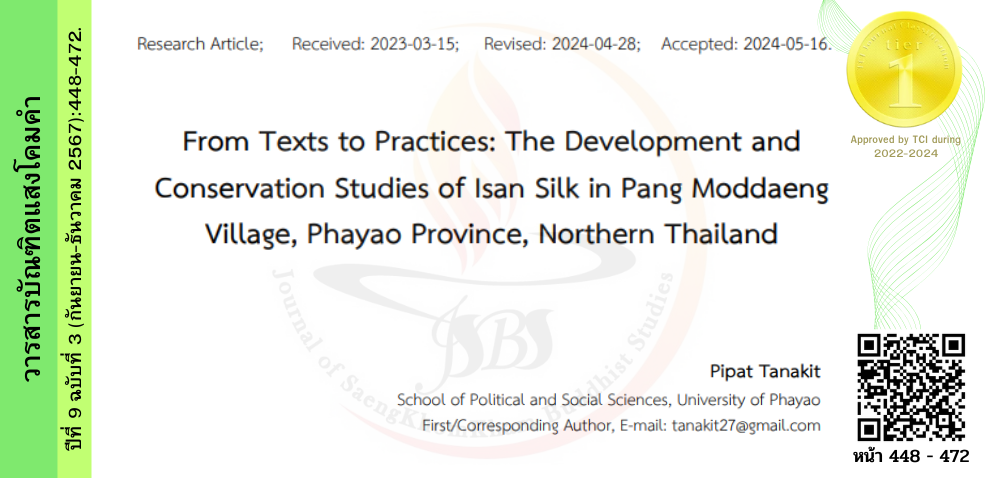From Texts to Practices: The Development and Conservation Studies of Isan Silk in Pang Moddaeng Village, Phayao Province, Northern Thailand
คำสำคัญ:
Isan Silk, Development of Production, Conservation of Production and Local Valueบทคัดย่อ
This paper is a part of a larger study of Isan women's negotiating for benefits from both development and conservation regimes in Pang Moddaeng village, Ang Thong sub-district, Phayao province, Northern Thailand. Two primary objectives include: 1) to study and analyse the distinguishable ideas, concepts, and schools of thought in current literature of silk, clothing, and other woven materials, and 2) to understand how these schools of thought’s ideas and concepts have spread into Pang Moddaeng village as a case study. To achieve these two objectives, this qualitative research employs three kinds of methodology. Firstly, it is the textual analysis by studying on 25 articles. Secondly, it employs an ethno-methodological approach for conducting participant observation. Lastly, the research was conducted in-depth interview and focus group interview.
The analysis of relevant literature discovered that there are three schools of thought that have led to the study of silk, garments, and other woven fabrics. Initially, it is the school of modernization, which is the mainstream of ideas for developing silk, clothing, and other woven materials to meet the needs of consumers and compete with the other woven fabrics in clothing market. Secondly, the anti-marketization school which is informed by the fundamental ideas of Marxism and political economics. This school of thought tried to counteract the first school of thought, which was concerned about the market undermining the essential value of silk, clothing, and other woven fabrics. Lastly, it is the conservation school of thought, which is influenced by localism and certain contributions from the second school of thought concerning the presence of essential values, and which could symbolize local wisdom, local knowledge, and local identity. Thus, this conservation school of thought has attempted to do research on the preservation of cultural items, which have those vital characteristics through preserving local silk, clothing, and other woven fabrics. While the latter was found that the numerous social actors in Pang Moddaeng, particularly the elderly and silk groups, were responsible for the structural production of these conceptions in the setting of the case study. It is vital to highlight that the communities have developed two distinct types of social units to cope with the two dominant ideas and concepts of Isan silk. As a result, on the one hand the village has run the silk group to manage with the silk production to follow the idea of modernization, while of the other hand the village has formed an elderly group to keep and create for the local knowledge/wisdom on Isan silk to follow the way to preserve Isan silk’s values.
Downloads
เอกสารอ้างอิง
Chaipratoom, J. (2013). Luang Prabang Woven Fabrics: The Dimensions of Cultural and Traditional Knowledge. Journal of Fine and Applied Arts, KhonKaen University. 5 (1), 129-156.
Hintow, B. (2014). Participatory Action Research for the Conservation on Local Wisdoms of Lao Kharang’s Woven Cloth. Parichart Journal, Thaksin University. 27 (3), 132-144.
Jakae, O. (2017). Local Wisdom Knowledge Management Process of the Hill Tribe Handicraft to Creative Economy: Case Study of Hmong and Mien Ethnic Groups in Kamphaeng Phet Province. The Golden Teak: Humanity and Social Science Journal (GTHJ.). 23 (3), 52-70.
Pasuta, K. and Mikhama, K. (2018). Strategy for Livelihood among Farmers’ Household Producing Woven Fabrics Dyed with Indigo in the Nawah District Area, Nakhon Phanom Province. Nakhon Phanom University Journal. 8 (2), 125-133.
Payakkapong, P., et al. (2007). The Value of Indigo Dyes in Capitalist Society. KKU Research Journal (Graduate Studies) Graduate School, Khon Kaen University. 7 (4), 117-129.
Ponsue, E., et al. (2019) Folk Fabric Making Groups Potential Development: A Case Study Bunglert Village, Bunglert Sub-district, Meyawadee District, Loi-et Province. Chophayom Journal. 30 (1), 241-249.
Smutkupt, S., et al. (1994). Ways of Isan Weavers: The Development of Textile Production and the Changing Roles of Women in Contemporary Isan Villages. Nakhonratchasima, Thailand: Institute of Social Technology, Suranaree University of Technology.
Thampranuam, P., et al. (2018). A Development of Community Enterprise of Sewing Garments by Using Participatory Action Research, in Ban Mae La Sub-district, Bang Rachan District, Sing Buri Province. Phranakhon Rajabhat Research Journal (Humanities and Social Science). 13 (1), 182-200.
Thanasanti, C. and Chaisena, M. (2017). The Development of Knowledge Management Model for Local Wisdom in Indigo Dyed Textile. Humanities and Social Sciences Journal, Ubon Ratchathani Rajabhat University. 8 (X), 252-267.
Thongprasert, N., et al. (2019). Product Development to Premium OTOP by Using Cultural Capital and Local Wisdom: A Case Study of Natural Dyne Silk of Hua Muang Weaving Women Group, Mahachanachai, Yasothon. Journal of Graduate School, Pitchayatat, Ubon Ratchathani Rajabhat University. 15 (1), 95-108.
Wichachai, N. and Buapheun, K. (2015). The Not So Bright Future of Praewa Silk: A Theoretical Analysis. Local Administration Journal. 8 (1), 27-36.
Yongpithayapong, P., et al. (2020) Knowledge Management in Local Wisdom of Tai-so Community Weaving Culture in Phon-Sawan District Nakhon Phanom Province. Walailak Abode of Cultural Journal. 20 (1), 49-61.

ดาวน์โหลด
เผยแพร่แล้ว
รูปแบบการอ้างอิง
ฉบับ
ประเภทบทความ
สัญญาอนุญาต
ลิขสิทธิ์ (c) 2024 วารสารบัณฑิตแสงโคมคำ

อนุญาตภายใต้เงื่อนไข Creative Commons Attribution-NonCommercial-NoDerivatives 4.0 International License.





